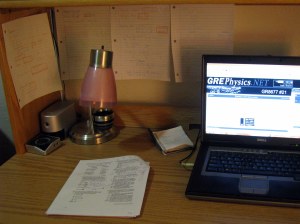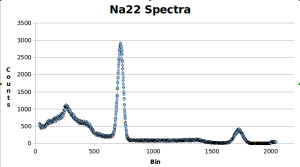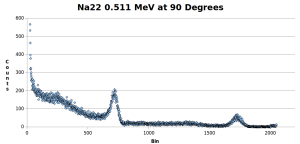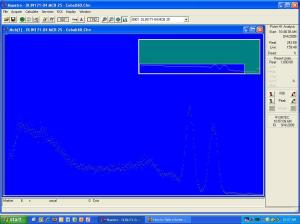Graduation
I’m a little late posting this, but I graduated college a couple of months ago! Graduation weekend was fun, and I got to show my family the lab where I have been doing research. They made sure to get some pictures of me looking like a “real scientist” . . .
Since then I’ve moved into my first apartment! I’ve been mostly taking the summer off, but I’ve been studying for the placement exams I’ll take when school starts. I’m also spending my time going to the farmers market, reading and cooking. In fact, I just made a beautiful (if I do say so myself) cake for my boyfriend’s birthday.
Yay grad school!
I few weeks ago I found out that I got into Rutgers for grad school. Since it was sort of last minute, I had a very quick drop everything and go trip up there, really enjoyed meeting the faculty and students in the department, and accepted the next day. I’m pretty excited about starting in the fall, and looking for apartments, finding a vegetarian co-op in the area etc. has been a fun distraction from my end of semester work.
Research has been quite slow this semester, since the vacuum system that we needed to move forward had a big leak. After taking the whole thing apart twice, and doing everything we could to find the leak, we finally gave up and used an older, smaller chamber. That meant ordering some more parts, and re-doing our sample chamber to make everything fit on the new set up. So, I didn’t get any data, but I learned alot about vacuum systems!
I think the highlight of my semester was my Computer Simulations class. It was (pretty much) my first time programming, and it went alot better than I expected! I was even able to do a pretty neat final project on acoustics. Even though I didn’t get the final results I wanted, I’m pretty happy that I could simulate the propagation of sound throughout a room (even if the boundary conditions did trip me up a bit).
Research Update – Timing Resolutions
I haven’t posted much about my research in quite a while since it’s hard to make calibrating electronics exciting in writing. But I thought I would give a summary of the overall goals and results of this calibration phase were, since I just finished this stage of the project a couple of days ago.
In case anyone forgot – the overarching goal of my research is to measure the lifetimes of positrons in various materials. Basically, positrons wander around a material until encountering their anti-matter counterpart (electrons). When the two meet they annihilate, emitting radiation. Before I can time how long the positron was able to wander I need to determine how precisely the instruments I am using can measure lifetime, so that I can account for this error later on. The degree of precision I can attain from the electronics is called the timing resolution.
For my first measurements of the timing resolution I looked at Cobalt 60 (60Co). In this source, any positrons created by radioactive decay annihilate immediately – so theoretically there should be 0 nanoseconds (ns) between the detection of a positron being born and annihilated. But when we take a timing spectra, our data shows up as a Gaussian, like the one shown below. This tells us that there is some error introduced by the electronics, and to quantify that error as timing resolution we measure the width of a Gaussian that fits the data at half it’s height (FWHM).
In this case there are two Gaussians making up the timing resolution. After changing many settings on the timing electronics, the best (smallest) FWHM of the main contributor to the timing resolution (the red curve) I measured was 0.29 ns (a nanosecond is 10^-9 s).
When we take the timing spectra of a source whose positrons do not immediately annihilate, we should find that the lifetimes fall off as a decreasing exponential. However, it is standard to plot on semi-log axes (take the log of the vertical axis), so we actually observe a decreasing linear function. We also have to take into account the timing resolution, which is in the form of a Gaussian. When you combine these (really a convolution) you get a function like the one in red in the picture below.
The red function is what our lifetime spectra will actually look like. The timing resolution for a source that actually has a lifetime component will be a bit bigger than that from a source where positrons immediately annihilate. I therefore needed to measure the timing resolution again, using a source that also has a lifetime component (I used Bismuth). The idea is to isolate the Gaussian part of the red function above, and measure it’s FWHM like we did previously with Co60. Bismuth is a good source to use because it only has 1 lifetime, whose length is already well documented. To pull out the resolution function I used PATFIT- a program developed in the 1980s and originally written in Fortran. (Luckily my research advisor has adapted it to work with Labview to be a little more user friendly.) This program allowed me to guess how many Gaussians made up the resolution function and the FWHM of each. I initially tried a single Gaussian, and then two Gaussians with the FWHM’s I found using 60C0. The best fit I found used 3 Gaussians – the main one makes up 80% of the total resolution function, and the other two contribute 10% each.
The graph above shows the spectrum of Bismuth (blue) with the fitted resolution function in red. Unlike in previous posts, the vertical axis here is the number of times it took X ns for a positron to annihilate. So in this plot you can see that most of the positrons annihilated at 0 ns (this does not actually mean they annihilated instantaneously, the data has just been shifted). The timing resolution here was indeed bigger than 60Co, coming in at 0.5129 ns.
Armed with a resolution function for sources with lifetime components, I now take a spectra of a new source, 22Na. Unlike Bismuth, I do not know the lifetimes of positrons in 22Na, so I will use PATFIT and my resolution function to pull out information about the lifetime part of the data. Like before, I make some initial guesses until I get a good fit like the one shown below.

Positron lifetimes in a sodium 22 button source (blue) fitted with a resolution function and lifetime curve.
I find that there are two different lifetimes in 22Na. Sometimes the positrons get lucky and live for as long as 1.75 ns, and some only live for 0.28ns (depending on the kind of positron). These results are in pretty good agreement with the accepted lifetime values for positrons in such a source, but I will still try to minimize the timing resolution with a few additional adjustments. Once I make those final changes and then I will be ready to measure lifetimes of positrons in a variety of new materials.
Studying, studying
Somehow the fall has flown by and the dreaded physics GRE is next Saturday!! I’ve been studying to some extent since about September, but this weekend kicked off what should turn out to be a week of intense studying. I think I made good progress this weekend – I condensed all of the really important things into 7 review sheets, which I have hung up around my desk in a desperate attempt at learning by osmosis.

My desk at T-6 days til the physics GRE.
I also took my first full length, one sitting (for 3 hours!) practice test today. I’ve improved, but still not as much as I would like.
I took a break on Saturday to learn how to make Inarizushi from my friend Althea, who spent the past school year in Japan. They are fried tofu pockets stuffed with sushi rice, sesame, and shredded carrot. They were really easy to make and so good! A perfect lunch with some broccoli on the side.

Fall Break
Last weekend was fall break, so I had a nice, long weekend to relax with my family and boyfriend. We didn’t do too much, but we did venture into DC on Sunday for the National Equality March. It was very cool to see so many people out there marching for something they believe in. We also made banana’s fosters vegan ice cream, based on Vegan Dad‘s vanilla recipe. We have previously made his chocolate ice cream, and both were delicious. Sorry for the terrible pictures!
Vegan Cupcakes!
Right now research involves a lot of tinkering with electronics to see what effects they have on measurements, so I don’t have anything particularly interesting to report at the moment. So instead I thought I would do a quick post on vegan baking. This week I made a batch of Oreo cupcakes for the weekly physics coffee talk, and they were a big hit! A cupcake is pictured below, and was made from Kittee Cake and “Fluffy Vegan Buttercream Frosting” (which I know I found online somewhere, but can no longer locate. I would highly suggest making these yourself – they’re easy and really tasty!

Preliminary Coincidence Experiments
Since my last post, I have been working through a lab on nuclear spectroscopy to develop an understanding of the kind of equipment and techniques I will use later to measure the lifetimes of positrons. This involved setting up two of the detectors described in my last post and taking data on the photons emitted from the decay of the radioactive isotope 22Na.
Radioactive isotopes like 22Na are constantly emitting radiation as they decay in the form of gamma rays, positrons, electrons (Beta – particles), and helium nuclei (alpha particles). Using the detectors and software described previously I was able to measure the number of photons emitted at a various energies as 22Na decayed. An initial spectra revealed two distinct peaks, indicating that the sample was emitting radiation at two different energies. Consulting a reference on the known decay scheme of 22Na, I found that these peaks represented a 0.511 Mev gamma ray emitted from the annihilation of a positron, and a 1.28 MeV gamma ray emitted as part of the normal radioactive decay of the isotope. This spectra is shown below, and though the x axis is not yet calibrated for energy, the 1st peak corresponds to the 0.511 Mev gamma ray, and the 2nd to the 1.28 MeV ray.

To further investigate the decay, I turned to a more in depth measurement – coincidence spectra. Coincidence spectra determine whether two events occur at the same time. In this case, I wanted to know what was found in detector #2 at the same instant one of the 0.511 MeV gamma rays from positron annihilation was detected in detector #1. To accomplish this I used an SCA timing device and a gate to signal detector #2 to let measurements through only when a photon within a certain energy range (about 0.511 Mev) entered detector #1. This way I could see what else was emitted when the positron annihilation occurred.

When the detectors were aligned at 180° to each other (facing one another), with the 22Na sample in the center, spectra from detector #2 showed a peak at 0.511 MeV. This tells me the 0.511 Mev gamma ray has at least one partner gamma ray emitted during positron annihilation, which is what theory predicts. Before annihilation, the electron and positron (basically) have zero total momentum, and conservation of momentum requires that the system maintains this zero momentum after annihilation. To accomplish this, two gamma rays must be emitted with equal energies, in opposite directions – so that the sum of their momenta is zero. We should therefore expect to find the partner gamma ray at 180° relative to the detection of the first detected ray, and none in other directions.

However, turning the detectors so that they are at 90° relative to each other, with the sample in the center, we actually find a very small peak at 0.511 MeV (shown above). This is not an indication of the breakdown of conservation laws, but that there is actually a very small probability that during the brief time the gate lets signal pass in response to detection of the 1st 0.511 MeV gamma ray, a second positron annihilation occurs that happens to land in detector #2. We also find a small peak at 1.28 MeV, since there is also a chance of non-positron related emission during the time the gate is open.
I’m still working up to taking measurements for the core research, but after some more training oscilloscopes and other lab equipment coincidence spectra to measure the time between the birth and death of positronium.
New physics research!
I’ve been back at school for a couple weeks now, and have successfully arranged to do research in the physics department this year! I will be working with a professor to continue his work studying the lifetimes of positronium in various materials. I hope to post here every once in a while with understandable explanations of what I’ve been doing and anything cool I find out. I haven’t done much real research so far, but I have been doing some basic experiments to get used to the equipment I will be working with.

Gamma ray detector consists of two main parts – the scintillator and the photomultiplier tube (PMT). Gamma rays enter a slit on the front of the scintillator and a sodium iodide crystal changes the rays into a lower wavelength (about 420 nm) photon. This can happen in 2 ways: Compton scattering or the photelectric effect. In Compton scattering, the photon hits the electron at an angle, only imparting some of its energy and bouncing off at an angle. With the photoelectric effect, the photon gives up all of its energy as it is completely absorbed by the electron. The electron later re-radiates this energy at a lower wavelength.
The photons generated in the scintillator are then sent to the PMT, where they hit the photocathode. Here more electrons are knocked off the plate via the photoelectric effect. They are then sent through a series of charged plates, called dynodes, which double the number of electrons on each plate. By the end of the PMT, a large collection of electrons hits a final plate with an energy related to the energy of the initial gamma ray that hit the scintillator.
This energy is then amplified several times and fed into a computer where we can analyze the data. We get plots like this:

The spectrum of radioactive Cobalt 60.
which show the counts (number of times) for a certain bin #. The bin #s actually correspond to energy, and by taking data on radioactive sources with know gamma ray energies we can calibrate the x axis to tell us the energy of gamma rays we detect. In this plot you can see the detection of two gamma rays on the right hand side of the plot. These peaks are higher, sharper, and have more energy than the broad peak on the left. This is because the higher energy peaks are from photoelectric effect electrons in the scintillator (higher energy peak because the gamma rays gave the electrons all of their energy), while the broad peak on the left is the lower energy Compton radiation!
Eventually I will use this type of detector to calculate the time between the birth and death of positronium. Both the creation and annihilation of positronium emits a gamma ray, so I will be able to time how long positronium lives with these detectors.
Back in the States
After a hellish day of travel, starting at 3AM and lasting about 26 hours, I got back to the US on August 2nd. I had a nice week of relaxing and enjoying the comforts of home, and am now in Florida for the internship debriefing meeting. So far I’ve seen ALOT of presentations by students and faculty about gravitational wave physics, and am kind of in physics overload. It has been nice to talk to the other students about their summers, and experience the sort of nerdy physics camaraderie when we go out to dinner and such. Just wanted to give a quick update about what I’ve been up to since Italy, and maybe I’ll have something interesting to write about from one of the physics talks tomorrow.
Abruzzo and Rome
Just a quick update . . .
This weekend we went to Rome and got to see so many things – the Colosseum, the Vatican Museums, St. Peter’s Basilica

Soy gelato made my day!
, Piazza Navona and silly street performers, and some good food. We also saw hordes of the most ridiculous tourists I have every seen. I couldn’t believe how many people were touching and climbing on the priceless statues in the Vatican museums, and just how much people didn’t care about the rules against photos and talking in the Sistine Chapel. Overall the city was beautiful, quiet, and full of things to do, and we had a great time.
Last weekend we stayed with Antonello, his family, volunteers, and the other visitor’s at his farm in the Abruzzo region. The area was beautiful and we got to hike to a great waterfall in the mountains, undisturbed by anyone else. But maybe better than the natural beauty around us was the hospitality of the volunteers and family at the farm. Every night we had a delicious meal (they had no problems with vegans, yay!) of fresh food straight from the farm with the owner’s family and the other visitors. Antonello’s father brought many bottles of his homemade wine during our wonderful after dinner conversations with the other guests. Everyone was so friendly, and it was interesting to hear about everyone else’s travels around Europe.









You must be logged in to post a comment.